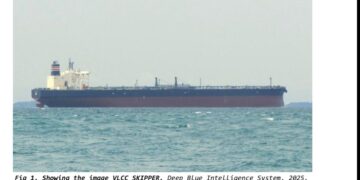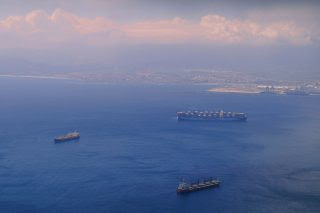Amendments to
the bunker delivery note entered into force on January 1, 2019, the
International Maritime Organization (IMO) said.
the bunker delivery note entered into force on January 1, 2019, the
International Maritime Organization (IMO) said.
The amendments relate to the
supply of marine fuel oil to ships which have fitted alternative mechanisms to
address sulphur emission requirements.
supply of marine fuel oil to ships which have fitted alternative mechanisms to
address sulphur emission requirements.
The amendment enters into force as
the shipping industry counts down to January 1, 2020, when the limit for
sulphur in fuel oil will be reduced to 0.50% m/m outside emission control areas
(ECAs), from 3.5% currently.
the shipping industry counts down to January 1, 2020, when the limit for
sulphur in fuel oil will be reduced to 0.50% m/m outside emission control areas
(ECAs), from 3.5% currently.
In ECAs, the limit will remain at
0.10% m/m. It applies to the four areas — the Baltic Sea area, the North
Sea area, the North American area, and the US Caribbean Sea area.
0.10% m/m. It applies to the four areas — the Baltic Sea area, the North
Sea area, the North American area, and the US Caribbean Sea area.
The amendments to Appendix V of
MARPOL Annex VI are intended to address situations where the fuel oil supplied
does not meet low sulphur requirements, but has been supplied to a ship which
is using an alternative compliance method permitted under regulation 4 of
MARPOL Annex VI to reduce the sulphur oxide emissions of the ship in order to
comply with MARPOL requirements. An equivalent means may be abatement
technology such as a scrubber, if accepted by the flag state of a ship as an
alternative means to meet the sulphur limit requirement.
MARPOL Annex VI are intended to address situations where the fuel oil supplied
does not meet low sulphur requirements, but has been supplied to a ship which
is using an alternative compliance method permitted under regulation 4 of
MARPOL Annex VI to reduce the sulphur oxide emissions of the ship in order to
comply with MARPOL requirements. An equivalent means may be abatement
technology such as a scrubber, if accepted by the flag state of a ship as an
alternative means to meet the sulphur limit requirement.
In October 2018, IMO’s Marine
Environment Protection Committee (MEPC) adopted a further amendment to MARPOL
Annex VI, which will prohibit the carriage of non-compliant fuel oil for
combustion purposes for propulsion or operation on board a ship – unless the
ship has an equivalent compliance method. This amendment is expected to enter
into force on March 1, 2020.
Environment Protection Committee (MEPC) adopted a further amendment to MARPOL
Annex VI, which will prohibit the carriage of non-compliant fuel oil for
combustion purposes for propulsion or operation on board a ship – unless the
ship has an equivalent compliance method. This amendment is expected to enter
into force on March 1, 2020.
Also on January 1, 2019,
amendments to MARPOL Annex VI to designate the North Sea and the Baltic Sea as
ECAs for nitrogen oxides (NOx) entered into force. Both ECAs will take effect
on January 1, 2021, and will result in considerably lower emissions of NOx from
international shipping in those sea areas.
amendments to MARPOL Annex VI to designate the North Sea and the Baltic Sea as
ECAs for nitrogen oxides (NOx) entered into force. Both ECAs will take effect
on January 1, 2021, and will result in considerably lower emissions of NOx from
international shipping in those sea areas.
From January 1, 2019, ships of
5,000 gross tonnage and above need to start collecting data on their fuel-oil
consumption, under the mandatory data collection reporting requirements which
entered into force in March 2018. The aggregated data is reported to the flag
state and transferred to IMO.
5,000 gross tonnage and above need to start collecting data on their fuel-oil
consumption, under the mandatory data collection reporting requirements which
entered into force in March 2018. The aggregated data is reported to the flag
state and transferred to IMO.
The data collection system is one
of the measures taken which will support the implementation of IMO’s Initial
IMO Strategy on Reduction of GHG Emissions from Ships, adopted in 2018.
of the measures taken which will support the implementation of IMO’s Initial
IMO Strategy on Reduction of GHG Emissions from Ships, adopted in 2018.
What is more, the 2017 set of
amendments (04-17) to the International Maritime Solid Bulk Cargoes Code (IMSBC
Code) cargoes entered into force on January 1, 2019.
amendments (04-17) to the International Maritime Solid Bulk Cargoes Code (IMSBC
Code) cargoes entered into force on January 1, 2019.
The amendments include
requirements for the shipper to declare whether or not a solid bulk cargo,
other than grain, is harmful to the marine environment.
requirements for the shipper to declare whether or not a solid bulk cargo,
other than grain, is harmful to the marine environment.
Other amendments include updated
carriage requirements for a number of specific cargoes and amendments to
highlighting the responsibility of the shipper for ensuring that a test to
determine the transportable moisture limit (TML) of a solid bulk cargo is
conducted.
carriage requirements for a number of specific cargoes and amendments to
highlighting the responsibility of the shipper for ensuring that a test to
determine the transportable moisture limit (TML) of a solid bulk cargo is
conducted.
World Maritime News






























































